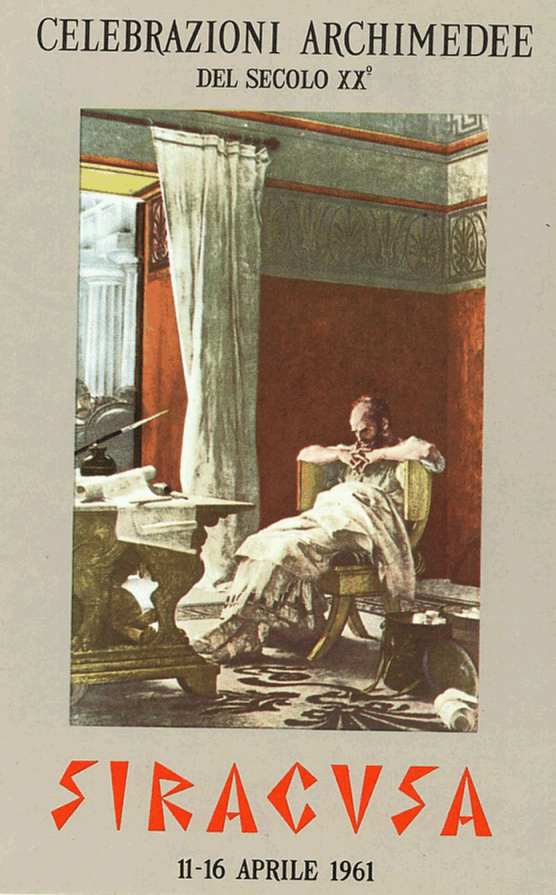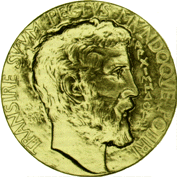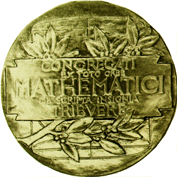.
Archimedes der Mathematiker
Part 2
Measurement of a circle ( &Kappaύκλου μέτρησις): π is between 3 10/71 and 3 1/7
This approximation could be known before but Archimedes provided methods for better approximations for π that provide lower and upper limits. He obtained the approximation, circumscribing and inscribing the circle with regular polygons having 96 sides. He used for this method also the approximation 265/153 for the square root of 3. Ptolemy (85-165 AD) later obtained the approximation = 3 17/120 = 3.14167 using an inscribed 360-gon I have found the following information:
What Archimedes did was to obtain nice recursion formulas for the perimeters in term of geometric and harmonic averages (Q_2n = H(P_n,Q_n) and P_2n = G(P_n,Q_2n), where P_n is the perimeter of the inscribed n-polygon and Q_n is the perimeter of the circumscribed n-polygon), which he had to use together with some fairly accurate numerical method for estimating square roots. Archimedes did not use any means of the inscribed and circumscribed lengths. He did the inscribed ones recursively and he did the outside ones similarly. By the way, he explicitly made the assumption that a convex curve inside another curve is shorter. Another mention of convexity in his work is his assumption (axiom) that the center of gravity of a convex set lies within the set.
Text in Greek Archimède tome II, p. 138-143 ed. Ch. Mugler, Paris 1971
Archimedes of Syracuse was the first to show around 250 BC that the “two possible Pi's" are the same. Clearly for a circle of radius r and diameter d, Area= π1r2 while Perimeter = π2d, but that π1 = π2 is not obvious. This is often overlooked. Jonathan M. Borwein, The Life of Pi: From Archimedes to Eniac and Beyond. From this source is also a nice mnemonics for the first 60 decimal digits of π. If you remember the poem below then the digits of π can be obtained from the number of symbols of each word.
Now I , even I, would celebrate
In rhyme inapt, the great
Immortal Syracusan, rivaled nevermore,
Who in his wondrous lore,
Passed on before
Left men for guidance
How to circles mensurate."
How I want a drink, alcoholic of course,
after the heavy lectures involving quantum
mechanics."
See I have a rhyme assisting my feeble
brain its tasks ofttimes resisting."
www.expmath.info for information and references about π
A Mathematica notebook: PDF File in German about the Archimedes approximation method
-
The cattle problem (Πρόβλημα &Betaοεικόν)

Louvre Museum, Paris France. The Cattle of Sun (and a rabbit!)
If thou art diligent and wise, O stranger, compute the number of cattle of the Sun, who once upon a time grazed on the fields of the Thrinacian [three-cornered] isle of Sicily, divided into four herds of different colors, one milk white, another a glossy black, a third yellow and the last dappled. In each herd were bulls, mighty in number according to these proportions: Understand, stranger, that the white bulls were equal to a half and a third of the black together with the whole of the yellow, while the black were equal to the fourth part of the dappled and a fifth, together with, once more, the whole of the yellow. Observe further that the remaining bulls, the dappled, were equal to a sixth part of the white and a seventh, together with all of the yellow. . . .
Archimedes
Only with modern computers it was possible to obtain this number. The problem was solved by Amthor showing that the smallest solution has 206545 digits. Amthor provided the 4 first digits who reduced the problem to a Pell equation. The smallest total cattle number was calculated 1981 using a CRAY-1 computer in about 10 minutes.
The first and last digits of one solution are:
77602714064868182695302328332138866642323224059233 ...05994630144292500354883118973723406626719455081800
I don't know what anybody would do with a solution, once found, except use it as a piece of mathematical wall-paper!
D. H. Fowler
Ilan Vardi in 1998 obtained using the Computer Program Mathematica a simple formula for the solution. It is the smallest integer number that exceeds the number
(p/q)(a+b*sqrt(4729494))4658
Where p = 25194541, q = 184119152, a = 109931986732829734979866232821433543901088049 and
b = 50549485234315033074477819735540408986340
Was the letter with the Cattle problem of Archimedes to Eratosthenes really written by Archimedes as the manuscript describing this problem was found 1773 by Gotthold Ephraim Lessing? The solution of this problem is a number of the order of 10206545. In comparison the number of grains of sand of Archimedes that fill the entire universe (or even that which are required to fill our larger universe as we know today ) is nothing compared to the population of the cattle. The cattle is far far larger than the number of all the sand grains that can fill the entire Universe! Homer describes the number of the cattle of Helios to 350 which is a more realistic number. If Archimedes indeed described this problem then in having this problem a integer solution and of such magnitude that seems not possible to solve without computer it would be really astonishing showing that Archimedes knew more that we know.
It seems impossible that a solution was found by Archimedes considering the complex notation for Greek numbers as the smallest solution for this number in Greek notation would be described as:
The 7th unit of 2 myriad 5819th numbers, and the 7602 myriad 7140th unit of 2 myriad 5815th numbers, and the 6486 myriad 8182nd unit of 2 myriad 5817th numbers,...,and the 9738 myriad 2340th unit of 3rd numbers, and the 6626 myriad 7194th unit of 2nd numbers, and 5508 myriad 1800.
Many of the manuscripts of Archimedes were lost by the fire in the library of Alexandria. Copies and translations also have been destroyed later such as the the document found this century overwritten with prayers by a Christian Monk where the text of Archimedes could be partially be restored.
See also: http://www.mcs.drexel.edu/~crorres/Archimedes/Cattle/Statement.html

Archimedes Congress in 1961 in Syracuse.
-
The 13 semiregular convex polyhedra of Archimedes (περί 13 ημικανονικών &piολυέδρων)
See also:
http://www.mcs.drexel.edu/~crorres/Archimedes/Solids/Pappus.html
- On plane equilibriums (Επιπέδων &iotaσορροπιών) Archimedes determines the centre of gravity of a parallelogram, a triangle, a trapezium, of a segment of a parabola.
- Archimedes and the Arbelos
- Archimedes cubic and bi-quadratic equations and a method for angle trisection
- Archimedes calculated the intersection volume of 2 cylinders
Archimedes calculated the chamber formed by the intersection of two equal right circular cylinders whose axes intersect at right angles.
See http://www.mathpages.com/home/kmath343.htm and
Eric W. Weisstein. "Steinmetz Solid." From MathWorld--A Wolfram Web Resource. http://mathworld.wolfram.com/SteinmetzSolid.html
- Archimedes: The Theorem of the Broken Chord
- Archimedes and the Heptagon (An arabic work that discusses the construction of a Heptagon by Archimedes according to Thabit Ibn Qurra) (Possible if the Neusis construction is used).


Fields medal front and back side; The most important prize for “young” mathematicians with the image of Archimedes.
References
Archimedes Cattle Problem by Ilan Vardi, www.oxy.edu/~ilan/
A. Amthor, Das Problema bovinum des Archimedes, Zeitschrift für Math. u. Physik (Hist. litt. Abtheilung) 25 (1880) 153-171
D. H. Fowler Archimedes "Cattle Problem" and the pocket calculating machine, University of Warwick, Math. Inst. Preprint 1980, supplemented 1981
Laubenbacher and Pengelley, Mathematical Expeditions: Chronicles by the Explorers, 1999
LINKS
Archimedes and the Square Root of 3
Better than Archimedes , Archimedes on Spheres and Cylinders
Eureka, the journal of the Archimedeans, the Mathematics Society of the University of Cambridge
Did Archimedes Know Gauss-Bonnet?
Eric W. Weisstein. "Neusis Construction." From MathWorld--A Wolfram Web Resource. http://mathworld.wolfram.com/NeusisConstruction.html
Eric W. Weisstein. "Heptagon." From MathWorld--A Wolfram Web Resource. http://mathworld.wolfram.com/Heptagon.html
The death of Archimedes, a transition to a new era
Recursive Functions (including Archimedes Psammites) Stanford Encyclopedia of Philosophy
Archimedes and Combinatorial Problems (The loculus of Archimedes)
Archimedes the Arbelos and the Salinon
See for more details
| Ancient Greece
Science, Technology , Medicine , Warfare, , Biographies , Life , Cities/Places/Maps , Arts , Literature , Philosophy ,Olympics, Mythology , History , Images Medieval Greece / Byzantine Empire Science, Technology, Arts, , Warfare , Literature, Biographies, Icons, History Modern Greece Cities, Islands, Regions, Fauna/Flora ,Biographies , History , Warfare, Science/Technology, Literature, Music , Arts , Film/Actors , Sport , Fashion --- |

